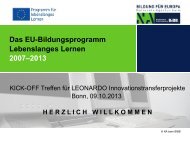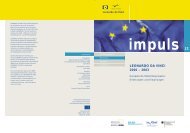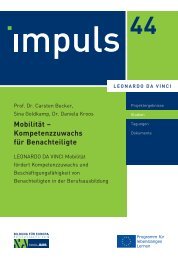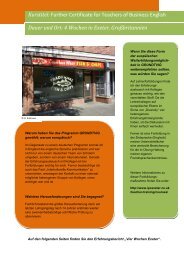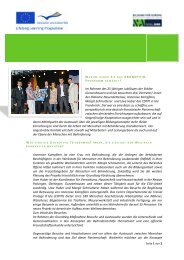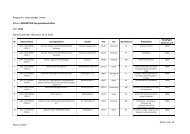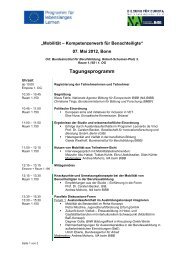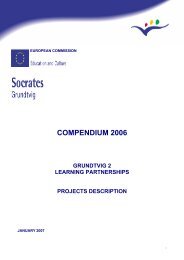Create successful ePaper yourself
Turn your PDF publications into a flip-book with our unique Google optimized e-Paper software.
In the second case study, Sylvie Bonichon<br />
from the Ministère de l’enseignement<br />
supéri<strong>eu</strong>r in France explained<br />
how a two-year higher VET qualification<br />
(EQF Level 5.) had been redesigned<br />
to accommodate the ECVET and the<br />
ECTS credit systems. This has allowed<br />
students to transfer between this higher<br />
VET course and universities and have<br />
their prior learning recognised. This<br />
enables students who, after their first<br />
year at university, fail or simply want to<br />
change direction to join a professional<br />
course to train for a specific job. It<br />
also enables VET students who decide<br />
to take a longer course to move to a<br />
university. The national initiative (<strong>www</strong>.<br />
<strong>ecvet</strong>-projects.<strong>eu</strong>) began in 2011 and<br />
covers five different subject areas. In<br />
2015, following the completion of the<br />
evaluation, the new approach to the Diploma<br />
could be implemented in every<br />
vocational sector.<br />
In the third case study Dorien Krassenberg<br />
and John Bres from the Branche<br />
Bureau Mode in the Netherlands demonstrated<br />
how employers’ organisations<br />
have been actively involved in<br />
designing vocational qualifications. A<br />
Level 3 qualification for sales specialists<br />
(<strong>www</strong>.<strong>ecvet</strong>-<strong>team</strong>.<strong>eu</strong>) was used to illustrate<br />
how three parts of the retail sector<br />
– fashion, supermarkets and electrical<br />
retailing - had been able to adjust the<br />
structure of the qualification to meet<br />
their needs. This had led to a qualifi-<br />
cation which was both standardised<br />
and tailored to the needs of the labour<br />
market. Alongside the formal qualification,<br />
some employers’ branches (e.g.<br />
fashion) offer students and employees<br />
a non-formal training route that leads to<br />
the award of a diploma.<br />
The ideas and approaches outlined<br />
in each case study were developed in<br />
discussion groups with delegates from<br />
each of the EQAVET, EQF and ECVET<br />
networks as well as colleagues from the<br />
higher education sector. The case studies<br />
showed how flexibility and specialisation<br />
could be combined through the<br />
use of units. This way of designing qualifications<br />
also allowed individual units to<br />
be easily up-dated to reflect emerging<br />
labour market trends and new ways of<br />
thinking. It also facilitated:<br />
• mobility as time abroad or in another<br />
context could focus on specific units;<br />
• lifelong learning as experienced staff<br />
could complete only the units that<br />
they needed (this was one way of recognising<br />
prior learning);<br />
• recognition of non-formal learning;<br />
• specialist and/or work-based VET<br />
providers offering the units where they<br />
have expertise (it is often easier for<br />
specialist organisations to offer parts<br />
of a qualification rather than the full<br />
qualification);<br />
• those learners who needed more time<br />
to complete the qualification, or needed<br />
to take time out of their study.<br />
The case studies highlighted the difficulties<br />
faced by those that wish to organise<br />
mobility between countries and<br />
between the VET and higher education<br />
sectors. The case studies illustrated<br />
the importance of ‘mutual trust’ and<br />
the subsequent discussions considered<br />
how this could be developed and<br />
sustained. There was a strong feeling<br />
that formal agreements were needed,<br />
preferably ones that were based on<br />
learning outcomes rather than ‘credits’<br />
or ‘points.’ Creating these agreements<br />
can be easier for the higher education<br />
sector as ECTS has been the basis for<br />
similar agreements across Europe for<br />
a number of years, and ECVET is just<br />
starting the journey. Delegates felt that<br />
local or individual agreements gave the<br />
best opportunity for progress, and EQA-<br />
VET, EQF, ECVET and ECTS provide the<br />
basis for this type of agreement.<br />
Delegates discussed the need to place<br />
learners at the centre of the system. Too<br />
often decisions appeared to focus on<br />
the organisations in the system rather<br />
than the users of the system, namely<br />
students and employers. One obvious<br />
way to emphasise the users’ perspective<br />
was to focus more on high-quality<br />
work placements which meet the needs<br />
of employers and prepare students for<br />
<strong>www</strong>.<strong>ecvet</strong>-<strong>team</strong>.<strong>eu</strong> 05<br />
<strong>www</strong>.<strong>ecvet</strong>-projects.<strong>eu</strong>




